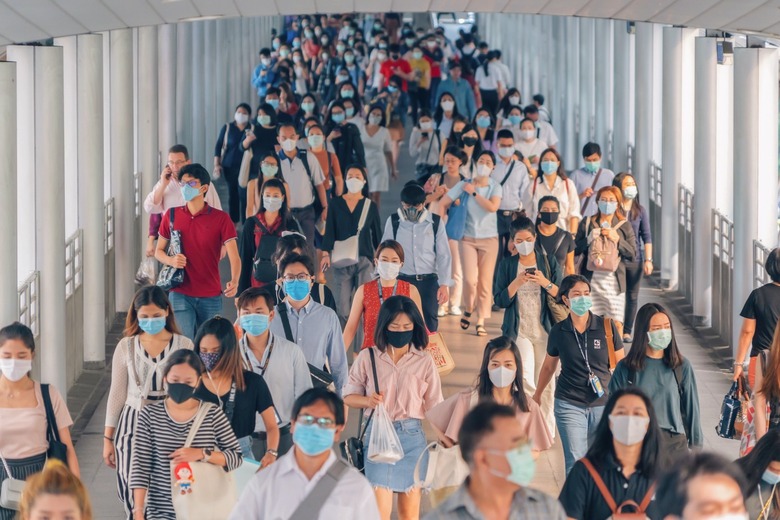CDC Issues Scary New Warning About A Deadly Coronavirus Complication
- Researchers have concluded that the scary post-coronavirus syndrome that can affect children weeks after recovery can also impact adults.
- The condition is described as multisystem inflammatory syndrome in adults (MIS-A) and is similar to the MIS-C illness seen in children.
- MIS-A symptoms might require intensive care and can be deadly, the CDC says.
- Scientists are warning doctors to be aware of MIS-A when diagnosing patients, noting that preventive measures taken for COVID-19 can also limit the number of MIS-A cases.
You might not be done with COVID-19 when you clear the novel coronavirus from your system, and that happens to be one of the worst effects of the virus. More than one million people have died of COVID-19 complications, out of more than 35.5 million cases confirmed worldwide so far. But many survivors find themselves fighting with all sorts of COVID-like symptoms long after beating the virus. Health experts trying to understand and treat this type of post-COVID illness have labeled it "Long COVID," a chronic affliction that may lead to several months of additional treatment. Now, new findings indicate that might not even be the worst-case scenario for coronavirus survivors.
Children infected with SARS-CoV-2 run the risk of developing a secondary syndrome that can be fatal if they also suffer from underlying conditions, or sometimes even for children who are otherwise healthy. The condition was first diagnosed in the UK this spring and then found all over the world. It's called multisystem inflammatory syndrome in children (MIS-C), it affects a variety of organs, and it can present weeks after a coronavirus infection is cleared. Doctors have warned in recent months that young adults might experience MIS-C as well, rather than solely young kids. Fast-forward to early October, and it turns out that even older adults can develop MIS-C. The condition is equally serious and can even be fatal, and it now has its own name: MIS-A.
Multisystem inflammatory syndrome in adults represents a collection of symptoms that can appear several weeks after a patient beats his or her COVID-19 infection. Scientists from the US and UK put together a study on the matter and published it on the CDC website.
MIS-A can be just as severe as COVID-19 and might require intensive care. It can also be deadly, with the study pointing out that three people died out of the 27 adults observed for the research.
The patients were aged 21 to 50 and one-third of them had circulating coronavirus antibodies that confirmed they had survived the infection. While the rest didn't test positive for antibodies, it's likely that they had still previously been infected with asymptomatic COVID-19. Recent studies have shown that some antibody tests are unreliable. Also, many COVID-19 survivors don't develop detectable levels of antibodies after beating the illness.
The doctors clarify that MIS-A should not be confused with severe COVID-19 even though the two conditions may share symptoms. MIS-A occurs without respiratory issues, which is a hallmark of severe COVID-19. Patients who develop complications after the infection with coronavirus might require oxygen therapy and mechanical ventilation. Of the MIS-A patients included in the study, just three were intubated.
MIS-A includes "cardiovascular, gastrointestinal, dermatologic, and neurologic symptoms," which explains the inclusion of "multisystem" in the condition's name. The symptoms appeared two to five weeks after coronavirus in patients who reported COVID-19 symptoms before the onset of MIS-A. These are some of the initial signs and symptoms the researchers observed:
Twelve of 16 patients had fever (≥100.4°F [38.0°C] for ≥24 hours or report of subjective fever lasting ≥24 hours) at the time of presentation. Six patients were initially evaluated for possible cardiac symptoms such as chest pain or palpitations; all 16 had evidence of cardiac effects, including electrocardiogram abnormalities such as arrhythmias, elevated troponin levels, or echocardiographic evidence of left or right ventricular dysfunction. Thirteen patients had gastrointestinal symptoms on admission; five had dermatologic manifestations on admission, including three with mucositis. Despite minimal respiratory symptoms, 10 patients had pulmonary ground glass opacities, and six had pleural effusions identified on chest imaging.
The study also indicates racial and ethnic minority groups are more likely to develop MIS-A, just like MIS-C. Only one of the 27 patients was white. Treating physicians are warned that they should not overlook MIS-A when treating patients:
Clinicians and health departments should consider MIS-A in adults with signs and symptoms compatible with the current working MIS-A case definition. Antibody testing for SARS-CoV-2 might be needed to confirm previous COVID-19 infection in patients who do not have positive SARS-CoV-2 PCR or antigen test results. Findings in this convenience sample emphasize the importance of collecting race/ethnicity data on case reports at the jurisdictional level. As with children, it is important that multidisciplinary care be considered to ensure optimal treatment. In the process of learning more from MIS-A cases, the working case definition might need to be revised in order to systematically conduct a call for cases.
The paper indicates that more research is required and that many cases of MIS-A have likely been overlooked or gone unnoticed. It's unclear whether MIS-A and the so-called "Long COVID" overlap in any way. It's also unclear whether other causes might lead to MIS-A.
